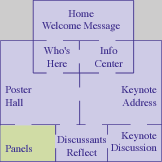Posted by:
Mark St. John
Posted on: May 08, 2002 at 11:46 AM
Message:
Susan, as usual, you speak with lots of experience. I bet that you and I can think of districts, especially large urban ones, that have received an NSF LSC grant and immediately appointed six "resource teachers" to be paid by the grant and to do the work. Unfortunately, these six teachers may not have the been the best, or even qualified, to do the work. Rather their assignments may well be solving another problem the district has...And it is also clear that sometimes the people who are given the improvement work are positioned on the margins of the district... Too often improvement happens as an add on... I can even remember a district that was engaged in a kits based LSC and at the same time continued the same old process of adopting an elementary science textbook, seeing no connection between the work of the temporary grant and the ongoing district ritual processes of curriculum adoption... But all of this simply makes the point I am trying to make clearer... And that is that it is going to be hard to achieve effective work from our investments... and certainly the sustainability of our investments ...without having districts and even schools reconceptualize the whole process and structure of improvement. There somehow needs to be a major reconceptualization about how the work of improvement gets down, its priority, and its funding. There are real limits to what outside funders can hope to achieve given the very limited capacity and resources that exist internally. Wouldn't it be great if NSF were receiving grants from districts that said: of course, we already have an elementary science improvement department. We have a skilled long time leader and a program that trains and rotates TOSAs on a three year basis. We have a materials science center and we have a process for ongoing curriculum improvement and refinement. What we need from NSF are additional funds to use this capacity to serve more of our teachers, to extend the offerings of our existing PD system, to develop and implement a literacy strand, to do equity trainings etc.... Thus, NSF would be investing in the work of an existing capacity instead of building all the capacity... I think that in science NSF invests in labs and people and units that have capacity to do research. Of course, they increase that capacity but there is no expectation that because of the NSF grant someone will build a whole new lab, train all the researchers, do some work, evaluate the work on its immediate impacts on practical applications, and then hope the lab is sustained three years later. So, yes, we should be careful what we wish for... There is no doubt that in the current climate we could "do improvement infrastructure" very badly. I am not suggesting a quick fix strategy...But rather I am suggesting a missing structural and conceptual element that is limiting what we can accomplish with our current funding strategies...
|


